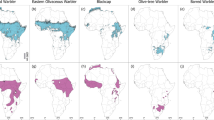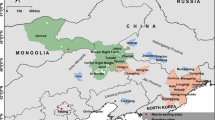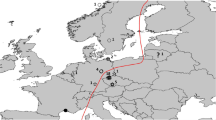Abstract
A crucial but elusive aspect of the effective conservation and management of migratory birds is the determination of which regions or habitats contribute to the recruitment of juvenile birds into the adult breeding population or, in the case of hunted species, the annual harvest. Although ring recoveries have provided important information for several game species, limitations of this approach include the bias to only marked populations and the tremendous scale of effort required to recover enough individuals. Here, we explored the use of an intrinsic marker, the stable hydrogen isotope composition of feathers (δ 2Hf) of juvenile woodcock (Scolopax rusticola), as a means of assigning birds to natal origin using a woodcock-specific δ 2Hf isoscape. We applied this approach to 987 juvenile woodcock during the winters of 2005–2006 and 2006–2007, and 1875 juvenile woodcock sampled during autumn migration of 2005 and 2006. We used a likelihood-based assignment approach to determine origins from four regions. Considering only the feather isotope data, the majority (50 %) were assigned to origins in the Baltic—Western European Russia region (including western Russia) and 44 % assigned to central European origins. Few (6 %) were considered residents in France and <1 % were assigned to northern Fennoscandia and northern European Russia. Using the amount of forest cover available within zones as a prior resulted in greater emphasis on origins in the Baltic and western European Russia (62 %) and less emphasis (29 %) on central Europe as a potential origin. We also depicted origins of birds on a continuous isoscape surface which emphasised more extant forests of central and eastern Europe and western Russia. Results were relatively similar regardless of whether we considered samples collected during migration versus those collected during the wintering period. Spatial assignment of 51 woodcock sampled in Switzerland was consistent with the Baltic and central Europe. Our results are in general agreement with ring-recovery data and emphasise the utility of an isotope approach to assignment of gamebirds to origin.





Similar content being viewed by others
References
Ashley P, Hobson KA, Van Wilgenburg SL, North N, Petrie S (2010) Linking Canadian harvested American Black Ducks to their natal areas using stable isotope analysis of δD, δ 13C, and δ 15N. Avian Conservation and Ecology 5:7. URL: http://www.ace-eco.org/vol5/iss2/art7/
Bauthian I, Grossmann F, Ferrand Y, Julliard R (2007) Quantifying the origin of woodcock wintering in France. J Wildl Manage 71(3):701–705
Bowen GJ, Wassenaar LI, Hobson KA (2005) Global application of stable hydrogen and oxygen isotopes to wildlife forensics. Oecologia 143(3):337–348
Burnham KP, Anderson DR (2002) Multimodel selection and multimodel inference: a practical information theoretic approach. Springer, New York
Ferrand Y, Gossmann F (2001) Elements for a woodcock (Scolopax rusticola) management plan. Game Wildl Sci 18(1):115–139
Ferrand Y, Gossmann F, Bastat C, Guénézan M. (2006) What census method for migrating and wintering Woodcock populations ? In: Sixth European Woodcock and Snipe Workshop. Proc. Int. Symp. of the Wetlands International Woodcock and Snipe Specialist Group, 25–27 November 2003, Nantes, Ferrand Y. ed., Wageningen, Wetlands Int., 37–43 (Int. Wader Studies 13).
Ferrand Y, Gossmann F (2009) Ageing and sexing series 5: ageing and sexing the Eurasian woodcock Scolopax rusticola. Wader Study Group Bulletin 116(2):75–79
Gossmann F, Ferrand Y, Fokin S, Iljinsky IV (2000) Ringing of woodcock (Scolopax rusticola) in Russia from 1991 to 1997. In: Kalchreuter H. Fifth European Woodcock and Snipe Workshop—Proceedings of an International Symposium of the Wetlands International Woodcock and Snipe Specialist Group 3–5 May 1998. Wetlands International Global Series no. 4. International Wader Studies 11, Wageningen, The Netherlands.pp. 10–14
Gunnarson G, Latorre-Margalef N, Van Wilgenburg SL, Hobson KA, Waldenström J, Elmberg J, Olsen B (2012) Disease dynamics and bird migration—linking mallards Anas platyrhynchos and influenza A virus in time and space. PLoS One 7(4):e35679. doi:10.1371/journal.pone.0035679
Guzmán JL, Ferrand Y, Arroyo B (2010) Origin and migration of woodcock Scolopax rusticola wintering in Spain. Eur J Wildl Res 57(3):647–655
Hijmans RJ, van Etten J (2012) raster: Geographic data analysis and modeling. R package version 2.0-41. http://CRAN.R-project.org/package=raster. Accessed 1 Nov 2012
Hobson KA (2003) Making migratory connections with stable isotopes. In: Berthold P, Gwinner E, Sonnenschein E (eds) Avian migration. Springer, New York, pp 379–392
Hobson KA, Wassenaar LI (2008) Tracking animal migration using stable isotopes. Handbook of terrestrial ecology series. Academic/Elsevier, Amsterdam
Hobson KA, Lormée H, Van Wilgenburg SL, Wassenaar LI, Boutin JM (2009a) Stable isotopes (δD) delineate the origins and migratory connectivity of harvested animals: the case of European woodpigeons. J Appl Ecol 46(3):572–581
Hobson KA, Wunder MB, Van Wilgenburg SL, Clark RG, Wassenaar LI (2009b) A method for investigating population declines of migratory birds using stable isotopes: origins of harvested lesser scaup in North America. PLoS One 4(11):e7915. doi:10.1371/journal.pone.0007915
Hobson KA, Van Wilgenburg SL, Wassenaar LI, Larson K (2012) Linking hydrogen (δ 2H) isotopes in feathers and precipitation: sources of variance and consequences for assignment to global isoscapes. PLoS One 7(4):e35137. doi:10.1371/journal.pone.0035137
Iljinsky IV, Fetisov SA, Ptschelinzev VG, Verevkin M, Golovan VI, Chistyakov DV (2000) First results of woodcock (Scolopax rusticola) ringing in the north-west regions of Russia. In: Kalchreuter H. Fifth European Woodcock and Snipe Workshop—Proceedings of an International Symposium of the Wetlands International Woodcock and Snipe Specialist Group 3–5 May 1998. Wetlands International Global Series no. 4. International Wader Studies 11, Wageningen, The Netherlands, pp. 15–18.
Kempeneers P, Sedano F, Seebach L, Strobl P, San-Miguel-Ayanz J (2011) Data fusion of different spatial resolution remote sensing images applied to forest type mapping. IEEE Trans Geosci Remote Sens 49(12):4977–4986
Päivinen R, Lehikoinen M, Schuck A, Häme T, Väätäinen S, Kennedy P, Folving S (2001) Combining Earth observation data and forest statistics. EFI Research Report 14. European Forest Institute, Joint Research Centre–European Commission. EUR 19911 EN
R Core Team (2012) R: a language and environment for statistical computing. R Foundation for Statistical Computing, Vienna, Austria. ISBN 3-900051-07-0, URL http://www.R-project.org/
Royle JA, Rubenstein DR (2004) The role of species abundance in determining the breeding origins of migratory birds using stable isotopes. Ecol Appl 14(6):1780–1788
Schuck A, Van Brusselen J, Päivinen R, Häme T, Kennedy P, Folving S (2002) Compilation of a calibrated European forest map derived from NOAA-AVHRR data. European Forest Institute. EFI Internal Report
Sillett TS, Holmes RT (2002) Variation in survivorship of a migratory songbird throughout its annual cycle. J Anim Ecol 71(2):296–308
Snow DW, Perrins CM (1998) The birds of the Western Palearctic. Vol. 1: Non-Passerines. Oxford University Press, Oxford
Tucker GM, Heath MF (1994) Birds in Europe: their conservation status. BirdLife Conservation Series. BirdLife International, Cambridge, no 3, 600 p.
Van Wilgenburg SL, Hobson KA (2011) Combining stable-isotope (δD) and band recovery data to improve probabilistic assignment of migratory birds to origin. Ecol Appl 21(4):1340–1351
Wassenaar LI, Hobson KA (2006) Stable-hydrogen isotope heterogeneity in keratinous materials: mass spectrometry and migratory wildlife tissue sampling strategies. Rapid Commun Mass Spectrom 20(16):2505–2510
Wassenaar LI, Hobson KA (2003) Comparative equilibration and online technique for determination of non-exchangeable hydrogen of keratins for use in animal migration studies. Isot Environ Healt S 39(3):211–217
Webster MS, Marra PP (2005) Importance of understanding migratory connectivity and seasonal interactions. In: Greenberg R, Marra PP (eds) Birds of two worlds: the ecology and evolution of migratory birds. Johns Hopkins University Press, Baltimore, pp 199–209
Acknowledgments
We thank all ringers of the Woodcock Network ONCFS/FNC/FDC and hunters of Club national des bécassiers and Bécassiers de France for their participation in the sampling. We thank P. Aubry for his help with sampling. A. Powell, A. Hoodless and A. Gossler graciously provided the woodcock calibration algorithm. C. Gryba and L. I. Wassenaar assisted with stable isotope analyses conducted at the Environment Canada stable isotope facility in Saskatoon, Canada. This study was funded by grants to KAH from Environment Canada and by support to YF by ONCSF. The manuscript benefitted from the constructive advice of two anonymous reviewers.
Author information
Authors and Affiliations
Corresponding author
Additional information
Communicated by C. Gortázar
Rights and permissions
About this article
Cite this article
Hobson, K.A., Van Wilgenburg, S.L., Ferrand, Y. et al. A stable isotope (δ 2H) approach to deriving origins of harvested woodcock (Scolopax rusticola) taken in France. Eur J Wildl Res 59, 881–892 (2013). https://doi.org/10.1007/s10344-013-0742-7
Received:
Revised:
Accepted:
Published:
Issue Date:
DOI: https://doi.org/10.1007/s10344-013-0742-7




